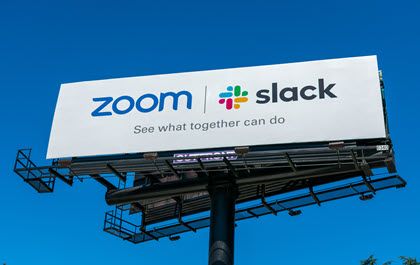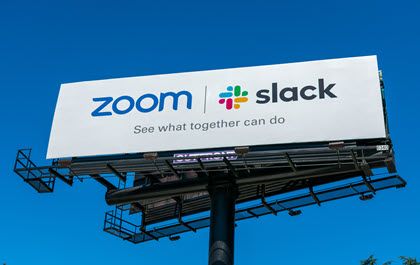Last week, both Zoom and Slack reported their quarterly earnings, the first real quarter with full COVID-19 impact. Zoom, by any standard, hit a home run. Slack also delivered a great quarter (at least a double or triple to extend the baseball analogy), but its stock price tanked, because Wall Street expected a Zoom-like quarter and was disappointed.
Investors, along with the financial and tech media, often lump Zoom and Slack in the same work-from-home (WFH) bucket, and thus place similar expectations on them. These expectations, which led to the wide divergence in post-earnings reactions, reveal a fundamental misunderstanding of just how different these two products are and could become in the future.

Slack is not a consumer app, Zoom could be
In its most basic form, Slack is a group messaging app, which gives off the impression that it is a consumer app. Slack is most certainly not a consumer app and does not have a consumer use case with a consumer market. Its core use case is workplace collaboration, particularly for engineers and developers as its main audience.
What sets Slack apart from other similar tools, though, is its consumer-like feel combined with both enterprise features and user experiences that delight developers, like webhooks, keyboard shortcuts, integration support, etc. In fact, inside some large tech companies, the more technical teams (e.g. engineering, product, data analytics) often use Slack, while the non-technical ones (e.g. marketing, sales, HR) use Microsoft.
Slack is very much at the forefront of a trend that’s driving the “consumerization” of enterprise products, but it’s ultimately still an enterprise product, focused particularly on the growing developer community. When Slack CEO, Stewart Butterfield, was answering a question about its new partnership with AWS (more on this topic below) during its Q1 2020 earnings call, he reinforced this positioning:
“Obviously, a lot of developers on AWS, SAP it's not a very popular tool with developers, and we really want to ensure that we keep that population happy.” -- Stewart Butterfield, Slack Q1 2020 earnings call
Zoom is also a leader in this “consumerization” trend. But what separates Zoom from Slack, and every other company in this space, is a real consumer use case for videoconferencing that the COVID-19 pandemic has exposed. Zoom weddings, birthday parties, dance and fitness classes, yoga, happy hours, game nights, etc. are now how people live. Zoom has become a “verb” company, like Google and Netflix. That can only happen if there is a consumer market for its product.
(Note: I’m purposely not including Zoom’s new usage in spaces like online education, healthcare, political campaigns, and local governments in this discussion, because I consider them B2B use cases, not consumer ones.)
Not surprisingly, many of the questions lobbed at Zoom CEO, Eric Yuan, during last week's earnings call were about his product vision for Zoom in the consumer space, all of which he smartly avoided, because that future, while full of potential, is too uncertain at the moment. This potential is also why his announcement -- free Zoom users (mostly consumers) will not have the end-to-end encryption feature that enterprise users (mostly companies) will have -- was met with intense scrutiny from privacy advocates.
For the consumers doing messaging, there are many alternatives to Slack. For the consumers doing videoconferencing (assuming there is a use case in the long-term), there are few alternatives to Zoom.
Slack will never eat into the market occupied by iMessage, Whatsapp, WeChat, Line, Signal, etc., nor should it be expected to. Zoom can and does eat into FaceTime, possibly spearheading a new consumer category for videoconferencing.
While Wall Street may have missed these differences, these two companies are already preparing for their two very different futures, as revealed by the way they are architecting their respective cloud infrastructures.
Zoom = Multi-Cloud; Slack = All-In AWS
Zoom has always been a multi-cloud company, using AWS, Azure, and its own data centers as infrastructure. Slack has always been built on top of only AWS. In the last few months, both companies have doubled down on their existing cloud infrastructure posture.
Zoom is expanding its multi-cloud sprawl, adding more AWS capabilities and Oracle Cloud into the fold. (I’ve discussed the Oracle addition at length in “Why Zoom Chose Oracle” as a strategic move to shore up more capacity at a good price and help expand into government contracts.) Curiously, Zoom has not expanded its usage of Azure, perhaps either due to competitive reasons with Microsoft Teams or the fact that Azure has little extra capacity to spare.
A recent report by The Information reveals that Zoom is in talks with Google to use GCP’s Web Risk API, a cybersecurity product that can potentially alert Zoom users to “links to such websites that scammers send to other users through Zoom’s chat function.” Google, who has been operating quite a few global-scale web services like Search and Gmail, has arguably the most expertise in helping Zoom users defend against these types of attacks.
If this deal with GCP materializes, it would protect Zoom users from phishing scams and look-alike domains, as the company tries to build its reputation as a trustworthy consumer product while figuring out what its consumer market playbook ought to be.
Taking a step back, Zoom’s multi-cloud posture is increasingly sophisticated -- using different cloud platforms for a specific, differentiating service -- in order to meet a future where it has to satisfy both large enterprise customers and everyday consumers.
Meanwhile, Slack is going all-in on AWS, now more than ever.
Prior to the most recent partnership announcement, Slack was already committed to spending at least $250 million USD on AWS over five years through 2023, as shown in its S1. The new partnership will commit Slack to spending at least $425 million USD on AWS over a five-year period that ends in April 2025. Two other noteworthy parts of the new partnership are:
- Amazon will use Slack internally for its 800,000 plus workforce, replacing IBM as Slack’s largest single customer by far.
- Slack will integrate Chime for its native voice and video calling feature, AWS’s own look alike product to Zoom and Microsoft’s Teams that has garnered little traction outside of Amazon internally. (Going forward, it will be interesting to see if Slack displays any “powered by Chime” type branding.)
Staking its future on AWS, arguably the most successful and most trusted cloud platform to date with both large enterprises and new startups, makes perfect sense for Slack. To continue its growth journey as an enterprise-grade SaaS, Slack is entrusted with its customers' entire work messaging history, along with employee information, shared files, and many integration points with other workplace tools. Building that trust by further integrating top of an already-trusted cloud platform like AWS is a no-brainer.
On the other hand, going multi-cloud may prove to be more trouble than it's worth. If a multi-cloud infrastructure isn’t architected and operationalized properly, it could lead to security issues with multi-tenancy or service downtime that directly leads to revenue losses. Slack has already suffered from this once while only operating on AWS -- a $8.2 million revenue loss caused by outages during its very first quarter as a public company. Further complicating its infrastructure stack might make things worse.
Of course, building on top of Azure would also yield similar benefits, given Azure’s strength among large enterprises. But Microsoft Teams’s rivalry with Slack, unhealthy or not, has precluded any partnership possibilities. Slack’s deepening relationship with AWS also forecloses the already remote possibility that Microsoft may acquire Slack.
The zero-sum rivalry between Slack and Teams is the exception, not the norm. Most of these relationships are interconnected and intertwining. Everyone in the cloud, SaaS, and broad enterprise tech industry is a “frenemy”. Zoom may use a GCP service, but it still competes with Google Meets. Dropbox has partnerships with both Microsoft and Google, but it still competes with OneDrive and GSuite, respectively. The “frenemy” list goes on.
I hope the takeaway from this analysis is not that Slack is a bad company. Slack is growing just fine, more than fine, by any enterprise SaaS standards. It just shouldn't be compared to Zoom.
Zoom is truly in a league of its own.
If you like what you've read, please SUBSCRIBE to the Interconnected email list. New posts will be delivered to your inbox (twice per week). Follow and interact with me on: Twitter, LinkedIn.
Zoom vs Slack:华尔街的错误比较
上周,Zoom和Slack两个公司都公布了季度业绩,也是第一个完全包括新冠疫情的有关影响的季度。无论用什么标准衡量,Zoom的业绩都是个本垒打。Slack的业绩也非常出色(起码是个二垒或三垒打),但它的股价却随即暴跌,因为华尔街对Slack的预期和Zoom一样,因此感到失望。
投资者,以及金融和科技媒体,经常把Zoom和Slack放在同一个“远程办公”的框架里,因此也对他们寄予了相似的期望,从而在股价上有了巨大的差异。这种差异揭示了大家对这两款产品的根本差异及它们的未来有很多基本层面的误解。

Slack不会面对消费者,Zoom很可能会
Slack最基本的功能是一个群组短信产品,所以给人的印象很想一个to C产品。但Slack绝对不是个to C产品,也没有消费者需求和用例。它的核心用例是办公协作,尤其针对工程师和开发者。
不过,Slack与其他类似的办公协作工具的不同之处在于,它把to C产品的用户体验和企业需要的功能结合在了一起,让开发者用的很爽,比如Webhook、键盘快捷键、与其他工具的集成支持等。在有些科技大厂里,更偏技术的团队(如工程、产品、数据分析)会用Slack,而非技术团队(如市场、销售、人事)则使用微软。
Slack在推动企业科技产品“to C化”的趋势中一直走在前沿,但它最终仍然是一个面对企业的产品,而且尤其专注赢得不断增长的开发者群体的认可。当Slack CEO,Stewart Butterfield,在Q1 2020财报电话会议上回答于AWS新的合作协议的时候,他加强了这个产品定位:
“很明显,很多开发者用AWS,SAP并不是一个非常受欢迎的工具,我们确实希望能确保开发者群体继续喜欢我们的产品。”——Stewart Butterfield,Q1 2020 Slack财报电话会议。
Zoom也是这一企业科技产品“to C化”趋势的领头人之一。但Zoom与Slack以及整个领域的其他公司的本质区别是,全球新冠疫情的扩散暴露出了一个真正的消费者对视频会议产品的需求和用例。Zoom上开的婚礼、生日party、舞蹈和健身课程、瑜伽、happy hour、桌游等现在都已经变成老百姓生活的一部分。Zoom能像Google和Netflix一样成为一个“动词”公司的前提是要有真正的消费者市场和需求。
(注:我有意没有包括Zoom在在线教育、医疗、大选组织活动和地方政府等领域的新型使用,因为我认为这些更是B2B类型的用例,而不是to C。)
毫不奇怪,在上周的财报电话会议上,抛给Zoom首席执行官袁征的许多问题都与他对Zoom未来在to C市场里的产品设想和展望有关。他也巧妙地回避了这些问题,因为这个未来虽然充满潜力来,但仍非常模糊。这也是为什么他的另一个宣布 -- 免费Zoom用户(主要是消费者)将不会像企业用户(主要是公司)一样享受端到端加密功能 -- 受到了隐私倡导群体的强烈谴责。
对于需要群组短信的消费者们来说,有很多现有产品也不需要Slack。对于需要多端视频的消费者们来说(假设这是个长期用例),除了Zoom之外几乎没有其他选择。
Slack永远不会步入iMessage、Whatsapp、微信、Line、Signal等产品的市场,也不应该期望如此。Zoom可以也已经开始步入FaceTime的市场,可能会创造一个新的to C视频会议的市场机会。
虽然华尔街看似忽略了这些差异,但这两家公司已经在为它们两个截然不同的未来做准备,看看他们各自不同的云基础设施搭建的方式就显而易见了。
Zoom用多云(Multi Cloud);Slack只用AWS
Zoom一直是一家多云(multi-cloud)公司,同时使用AWS、Azure和自己的数据中心作为基础设施。而Slack一直建立在AWS之上。在过去几个月里,两家公司都在自己现有的云基础设施搭建方向翻倍加速。
Zoom正在扩展自己的多云计划,增加了更多的AWS功能和Oracle云。(我在“Zoom为什么选择了Oracle”一文中详细讨论了与Oracle云合作的战略意义:优惠的容量价格及今后扩展政府生意的计划。)有意思的是,Zoom没有扩展其对Azure的应用,可能是由于与微软Teams产品的竞争原因,或者是因为Azure本身也没有多少额外的容量可以配置。
据科技媒体The Information最近的一份报道,Zoom正在与谷歌商谈使用GCP的“网络风险API”,是一款云上的网络安全产品,可以提醒Zoom用户小心和避免不良来源的网站侵犯。谷歌,从搜索引擎到Gmail,一直在运营着多个庞大的,有全球规模的网络服务。因此它也拥有最专业的技术和经验来帮助Zoom抵御对其众多免费用户的网络攻击。
如果Zoom与GCP达成这一协议,它会保护Zoom用户免受网络钓鱼欺诈和仿造类似域名的各种攻击。这会给Zoom赢得消费者的信赖加分,也会给公司赢得宝贵的时间来想清楚怎样把产品深入to C市场。
更宽一点来看,Zoom的多云姿态和水平越来越高,越来越复杂。已经以使用不同的云平台提供的特定的、与众不同的单个服务来满足自己未来的需求,这种进化也是有必要的。Zoom今后必须同时满足大型企业客户和日常消费者的需求。
与此同时,Slack现在比以往更加深入与AWS的合作和关系。
在最近这次合作宣布之前,Slack已经承诺在包括2023年的前五年内,在AWS上至少花费2.5亿美元,如公司的S1所示。新的合作将在2025年4月结束的前五年时间内,在AWS上花费至少4.25亿美元。这次新合作的另外两点值得注意的部分是:
- Amazon将向自己80多万名员工推广使用Slack,并取代IBM成为Slack迄今最大的客户。
- Slack将把其本地语音和视频通话功能与Chime集成。Chime即是AWS自己做的类似Zoom和Teams的通讯会议产品,但目前除了Amazon内部使用以外,在市场上没有什么用户和吸引力。(值得观察的是,接下来Slack产品内是否会有类似“powered by Chime”这种品牌语句或标签。)
Slack把自己的未来寄托在AWS上是个合理的选择。迄今为止,AWS是许多大型企业和创业公司最认可、最值得信赖,也是总体最成功的云平台。为了继续走好企业级SaaS这条发展路线,Slack需要牢靠的托管客户的整个办公短信消息历史,员工信息、共享文件和许多与其他办公工具的交接点。加深与AWS这种已经被信赖的云平台的合作,从而更好的赢得客户的信赖对Slack来说是件顺水推舟的事情。
从另一方面看,使用“多云”很可能会带来更多的麻烦。如果多云设施的架构和操作不当,可能会导致多租户的安全问题或服务中断,直接导致收入损失。Slack在仅在AWS上运营的期间就已经遭受了一次这种损失。在上市后的第一次季报,Slack透露了因为业务中断而造成的820万美元的收入损失。如果把基础设施进一步复杂化,可能会使情况更糟。
当然,许多大型企业客户也很信任Azure,所以在Azure上搭建SaaS产品也会带来类似的好处。但微软Teams与Slack的急剧激烈的竞争,不管健不健康,都完全排除了任何合作的可能。Slack与AWS日益加深的关系也排除了微软收购Slack的可能。
Slack和Teams之间的这种竞争是个例外,而不是常态。绝大部分的这些商业关系都是相互联系和交织的,而不是黑白你我分明的。在云计算、SaaS和整体企业科技服务行业里,每个公司既是伙伴也是对手。Zoom可能会使用GCP的服务,但它仍然与Google Meets竞争。Dropbox与微软和谷歌都有合作关系,但也仍然分别与OneDrive和GSuite竞争。这种“敌友共存”的关系很多。
我希望从这篇分析中得出的结论不是Slack是家糟糕的公司。从任何衡量企业SaaS的标准来看,Slack的增长都非常显著。只是它不应该与Zoom相比较。
Zoom空前的状态是无法比较的。
如果您喜欢所读的内容,请用email订阅加入“互联”。每周两次,新的文章将会直接送达您的邮箱。请在Twitter、LinkedIn上给个follow,与我交流互动!
